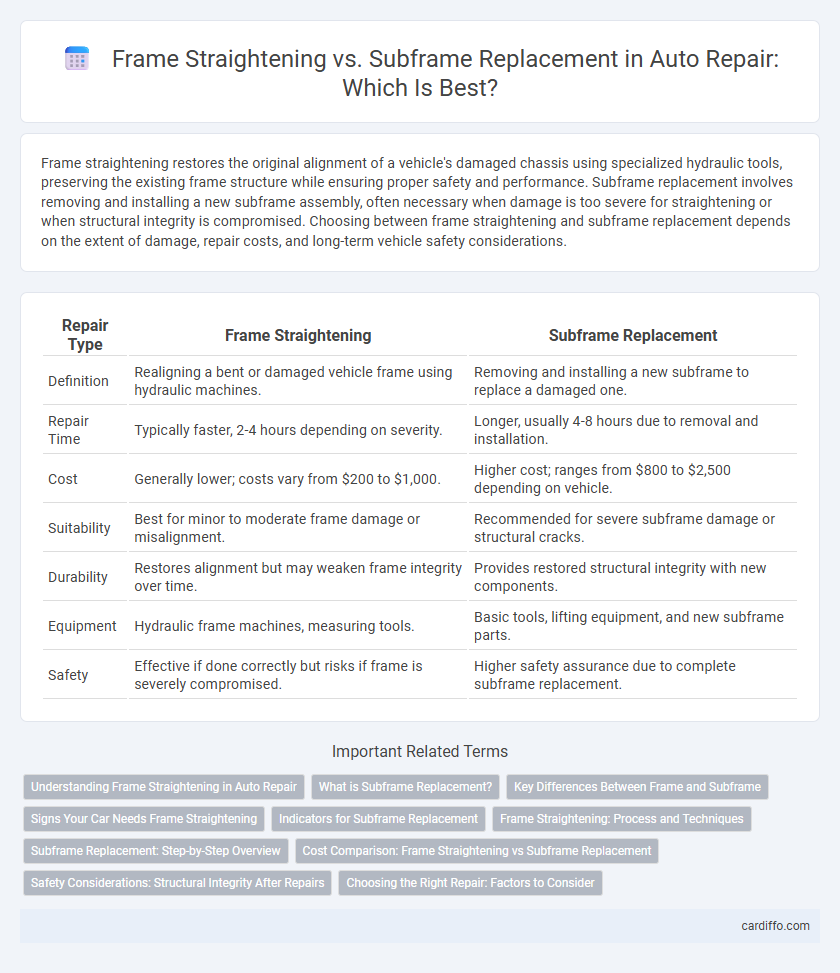Frame straightening restores the original alignment of a vehicle's damaged chassis using specialized hydraulic tools, preserving the existing frame structure while ensuring proper safety and performance. Subframe replacement involves removing and installing a new subframe assembly, often necessary when damage is too severe for straightening or when structural integrity is compromised. Choosing between frame straightening and subframe replacement depends on the extent of damage, repair costs, and long-term vehicle safety considerations.
Table of Comparison
| Repair Type | Frame Straightening | Subframe Replacement |
|---|---|---|
| Definition | Realigning a bent or damaged vehicle frame using hydraulic machines. | Removing and installing a new subframe to replace a damaged one. |
| Repair Time | Typically faster, 2-4 hours depending on severity. | Longer, usually 4-8 hours due to removal and installation. |
| Cost | Generally lower; costs vary from $200 to $1,000. | Higher cost; ranges from $800 to $2,500 depending on vehicle. |
| Suitability | Best for minor to moderate frame damage or misalignment. | Recommended for severe subframe damage or structural cracks. |
| Durability | Restores alignment but may weaken frame integrity over time. | Provides restored structural integrity with new components. |
| Equipment | Hydraulic frame machines, measuring tools. | Basic tools, lifting equipment, and new subframe parts. |
| Safety | Effective if done correctly but risks if frame is severely compromised. | Higher safety assurance due to complete subframe replacement. |
Understanding Frame Straightening in Auto Repair
Frame straightening in auto repair involves using specialized equipment to realign a vehicle's frame after it has been bent or twisted in a collision, ensuring structural integrity and proper alignment. This process restores the original factory specifications without the need for costly subframe replacement, preserving the vehicle's value and safety. Technicians rely on computerized measuring systems and hydraulic presses to achieve precise corrections critical for optimal vehicle performance.
What is Subframe Replacement?
Subframe replacement involves removing the damaged subframe, which supports the engine and suspension, and installing a new or refurbished unit to ensure structural integrity and alignment. Unlike frame straightening that repairs bent or twisted frames, subframe replacement is necessary when the subframe is severely cracked, corroded, or beyond repair. This procedure restores proper vehicle geometry, improves safety, and maintains handling performance after a collision or extensive damage.
Key Differences Between Frame and Subframe
Frame straightening involves realigning the main structural chassis after a collision to restore the vehicle's original shape, while subframe replacement entails removing and installing the detachable section that supports critical components like the engine and suspension. The frame is integral to overall vehicle integrity and crashworthiness, whereas the subframe acts as a modular unit designed for easier damage repair or part replacement. Frame repairs typically require heavy-duty equipment and precise measurements, contrasting with subframe replacement, which can be more cost-effective and less time-consuming.
Signs Your Car Needs Frame Straightening
Visible misalignment of doors, uneven tire wear, and a steering wheel that pulls to one side are clear signs your car needs frame straightening. Cracks or bends in the chassis, especially after an accident, indicate structural damage requiring professional frame straightening to restore safety and performance. Failure to address these issues can lead to compromised handling and increased risk of further damage.
Indicators for Subframe Replacement
Indicators for subframe replacement include severe structural damage, extensive corrosion compromising the frame's integrity, and significant misalignment that cannot be corrected through frame straightening. Collision impact zones showing deformation beyond manufacturer tolerances signal the need for subframe replacement to ensure vehicle safety and performance. Repeated repairs or cracks around subframe attachment points also indicate that replacement is necessary to restore proper vehicle function.
Frame Straightening: Process and Techniques
Frame straightening involves realigning a vehicle's chassis using hydraulic presses, computerized measuring systems, and specialized clamps to restore structural integrity after collisions. Technicians employ techniques such as pulling, pushing, and heating to correct bends or twists in the frame, ensuring proper suspension and wheel alignment for safe handling. Precision tools and laser-guided measurements guarantee the frame meets factory specifications to maintain vehicle performance and safety standards.
Subframe Replacement: Step-by-Step Overview
Subframe replacement involves carefully detaching the damaged subframe from the vehicle chassis and installing a new, manufacturer-approved subframe to restore structural integrity. The process begins with lifting the vehicle and removing components such as suspension parts, steering rack, and engine mounts connected to the subframe. Precision alignment and torque specifications are critical when bolting the new subframe to ensure proper geometry and safe vehicle handling.
Cost Comparison: Frame Straightening vs Subframe Replacement
Frame straightening typically costs between $500 and $1,500, depending on damage severity and vehicle type, while subframe replacement ranges from $1,200 to $3,500 due to higher parts and labor expenses. Frame straightening involves realigning the existing structure, making it more affordable when damage is minimal and localized. Subframe replacement becomes necessary if the frame has extensive damage or corrosion, leading to increased repair time and overall cost.
Safety Considerations: Structural Integrity After Repairs
Frame straightening restores the vehicle's original structural alignment, ensuring the chassis regains its designed crashworthiness and rigidity. Subframe replacement offers a more comprehensive solution when damage compromises critical attachment points, directly impacting the vehicle's crash energy absorption and overall safety. Assessing the extent of damage and quality of repair methods is crucial to maintain long-term structural integrity and occupant protection.
Choosing the Right Repair: Factors to Consider
Selecting between frame straightening and subframe replacement depends on the extent and location of structural damage. Frame straightening is suitable for minor bends and twists, restoring alignment with specialized equipment, while subframe replacement is necessary when corrosion, cracks, or severe impact compromises the subframe's integrity. Assessing repair costs, vehicle safety standards, and manufacturer's guidelines ensures optimal restoration and long-term durability.
Frame straightening vs subframe replacement Infographic

 cardiffo.com
cardiffo.com